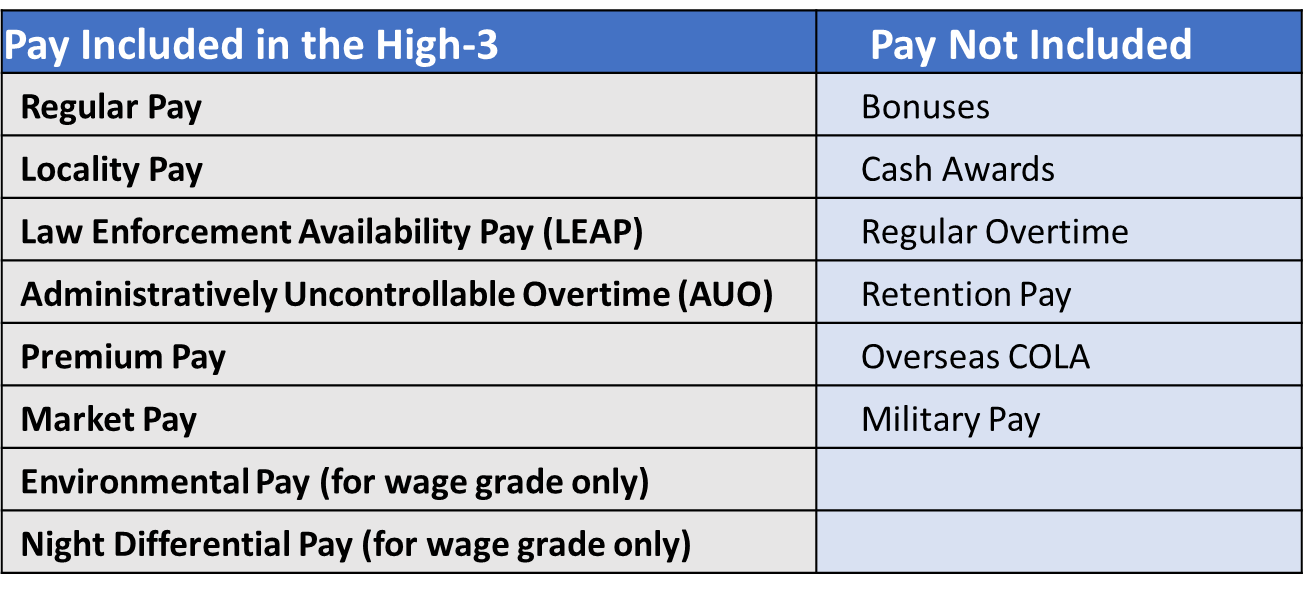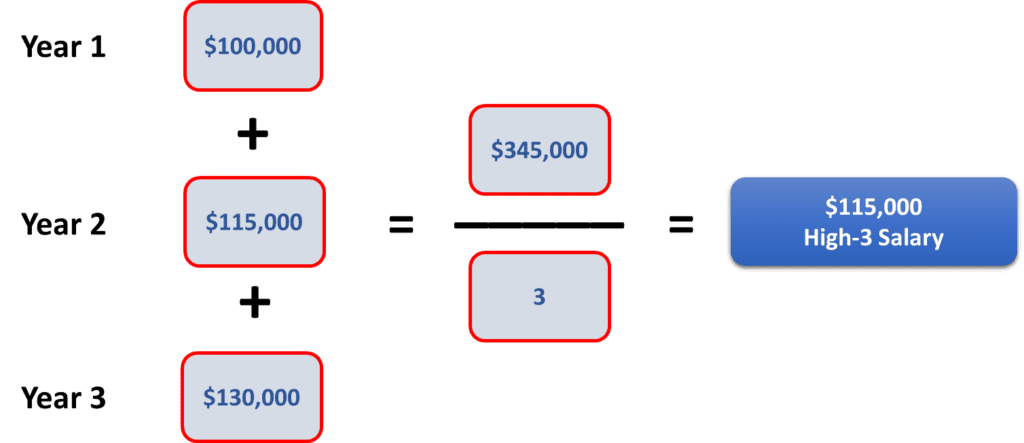Understanding Your Federal Retirement: Calculating Your High-3 Salary for FERS Pension
Planning for federal retirement is a critical step for any federal employee looking to ensure financial security in their later years. One essential component in this planning process is understanding and calculating your High-3 salary, especially if you’re part of the Federal Employees Retirement System (FERS). This article will guide you through the details of what the High-3 salary is, why it is important, and how you can accurately calculate it for your FERS pension. For a more in-depth overview, see this guide on calculating your Federal Retirement High-3.
Additional resources:
Calculate your FERS pension: FERS Retirement Calculator
Complete Guide to FERS – Federal Employee Retirement System
What is the High-3 Salary for FERS Retirement?
Defining the High-3 Average Salary
The High-3 average salary is a crucial metric used in determining federal retirement benefits. For FERS retirement, this refers to the highest average basic pay you earned during any three consecutive years of service (36-month moving average). It is not just your last three years of service but can be any period in your career where your salary is the highest. The calculation includes your basic pay and locality pay but excludes overtime, bonuses, and other forms of compensation.
What is included in the High-3 Calculation?
Not all pay is included in the FERS retirement high-3 calculation. The table below shows what is included in the high-3 calculation and what is excluded.

Why is the High-3 Salary Important?
The High-3 salary is paramount because it directly influences the amount of your retirement annuity. Essentially, the higher your calculated High-3 salary, the greater your pension benefits will be. It serves as the foundation upon which your retirement income is based, making it essential to understand and maximize this figure for a more comfortable retirement. A precise calculation can profoundly impact your quality of life post-retirement.
Who is Eligible to Calculate Their High-3 Salary?
Any federal employee who is part of the Federal Employees Retirement System (FERS) is eligible to calculate their High-3 salary. This includes full-time and part-time federal workers who meet the minimum retirement age and years of service requirements. Whether you’re approaching your retirement date or planning ahead, early calculation and understanding can aid in effective retirement planning and maximize retirement benefits.
Knowledge is Confidence!
How Do You Calculate Your High-3 Salary for Federal Retirement?
Steps to Calculate Your High-3 Salary
Calculating your High-3 salary involves a few straightforward steps. First, identify the highest-paid three consecutive years of your career. Next, total your basic pay and locality pay for each of those three years. Then, divide the combined total by three to get your high-3 average salary. Be sure to only include pay that counts towards your basic pay and exclude bonuses, overtime, or other extra payments.

Tools and Resources for Calculation
Several tools and resources are available to help federal employees in calculating their High-3 salary. The Office of Personnel Management (OPM) provides online calculators and guides, which can be highly beneficial. Additionally, many agencies offer workforce planning and retirement seminars to assist employees in understanding their retirement benefits. Human Resources departments are also valuable resources for personalized assistance.
Examples of High-3 Calculations
To illustrate, let’s consider a hypothetical federal worker. Assume the worker’s highest three consecutive years of salary are $85,000, $88,000, and $90,000. The total of these salaries is $263,000. Dividing this by three gives a High-3 average salary of approximately $87,666.67. This average is then used in the calculation of the worker’s FERS annuity and other retirement benefits.
Understanding FERS and CSRS: How They Affect Your High-3 Calculation
Differences Between FERS and CSRS
The Federal Employees Retirement System (FERS) and the Civil Service Retirement System (CSRS) are two distinct federal retirement systems, each with its own methods of calculation. FERS typically combines a smaller defined benefit pension with Social Security and Thrift Savings Plan (TSP) contributions, whereas CSRS, used primarily before 1987, is a more traditional pension plan. Understanding the nuances of these systems is critical in accurately calculating your High-3 salary for federal retirement. If you’d like additional background, you can explore how CSRS offset and the Windfall Elimination Provision may also impact certain retirees.
Impact of FERS Disability Retirement on High-3 Calculation
A federal employee who qualifies for FERS disability retirement may have different considerations for their High-3 calculation. Under disability retirement, the average salary may be computed based on the salary at the date of disability rather than seeking the highest earning period. Understanding these distinctions is vital to ensure accurate retirement income calculations.
FERS Annuity and Your High-3 Salary
The FERS annuity is calculated using a formula that includes your High-3 salary and your years of service. The basic formula is 1% of the High-3 average salary multiplied by the number of years of service, or 1.1% if you retire at age 62 or older with at least 20 years of service. This underscores the importance of acutely calculating your High-3 salary to maximize your annuity benefits.
Factors Affecting Your High-3 Salary: Basic Pay, Locality Pay, and Adjusted Basic Pay
Inclusion of Basic Pay and Locality Pay
In the calculation of the High-3 salary, basic pay is included, which is the pay rate established for your grade and step. In addition, locality pay, which accounts for cost-of-living differences in various geographic areas, is also included. This combination reflects the true value of your federal service compensation over the three consecutive years where your salary is the highest.
Understanding Adjusted Basic Pay
Adjusted basic pay represents your basic pay rate plus any locality adjustments but excludes any additional forms of compensation like bonuses or overtime. Understanding and correctly identifying these elements ensure that your High-3 calculation is accurate. It’s important to exclude any non-eligible components from the calculation to maintain precision.
Calculating High-3 Salary with Differing Pay Rates
If your pay rates have varied significantly throughout your career, calculating your High-3 salary can be more complex. You must accurately select periods that combine to offer the highest average, considering all eligible basic and locality pay during those times. Detailed records and accurate accounting play a significant role in ensuring a precise High-3 average salary.
Common Questions about High-3 Calculation for Federal Retirement
How Many Years Are Considered for the High-3 Calculation?
The High-3 calculation considers the three consecutive years in which your salary was the highest, known as the High-3 average salary period. These do not have to be your last three years of service but any period within your federal career. Accurate identification of this period is crucial for a proper estimate of your retirement benefits.
Can Bonuses and Overtime Affect Your High-3 Salary?
No, bonuses, overtime pay, and other one-time payments do not affect your High-3 salary calculation. Only your basic pay and locality adjustments are used in the high-3 average salary formulation. Ensuring that you are including only eligible compensation will help in maintaining the accuracy of your federal retirement calculations.
What Happens if You Have Less Than Three Years of Service?
If a federal worker has less than three years of service, the average salary calculation will include the highest pay earned during the actual period of service. However, due to the limited timeframe, the calculated average may be less than those with longer service periods, impacting the retirement benefits received upon reaching minimum retirement age or the chosen retirement date.
Reach Out to Us!
If you have additional federal benefit questions, contact our team of CERTIFIED FINANCIAL PLANNER™ (CFP®), Chartered Federal Employee Benefits Consultants (ChFEBC℠), and Accredited Investment Fiduciary (AIF®). At PlanWell, we are federal employee financial advisors with a focus on retirement planning. Learn more about our process designed for the career fed.
Preparing for federal retirement? Check out our scheduled federal retirement workshops. Sign up for our no-cost federal retirement webinars. Make sure to plan ahead and reserve your seat for our FERS webinar, held every three weeks. Want to have PlanWell host a federal retirement seminar for your agency? Reach out, and we’ll collaborate with HR to arrange an on-site FERS seminar.
Want to fast-track your federal retirement plan? Skip the FERS webinar and start a one-on-one conversation with a ChFEBC today. You can schedule a one-on-one meeting.










